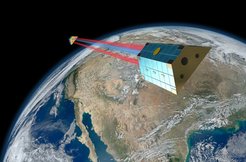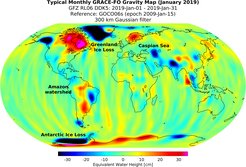Nearly 900 days of laser measurements in Earth orbit
Successful operation of the laser interferometer on board GRACE Follow-On began three years ago.
In mid-June 2018, it was “First Light!” for a novel laser instrument circling the Earth. The Laser Ranging Interferometer on both satellites of the German-US geodesy mission GRACE Follow-On was activated for the first time. At the first attempt, the instruments – 200 kilometers apart – were able to find each other 490 kilometers above the Earth's surface. Since then, the system has been running reliably and has been delivering high-precision distance measurements in scientific data taking mode. Now, researchers at the Max Planck Institute for Gravitational Physics (Albert Einstein Institute, AEI) and Leibniz University Hannover look back at the successful first three years and towards the future.
First Light on 14 June 2018

Three years ago, on 14 June 2018, researchers eagerly awaited the activation of their instrument on the GRACE Follow-On satellites. After a picture-perfect launch in mid-May 2018 they have been orbiting the Earth one after the other on a polar orbit. The two satellites have coin-sized holes, one for transmitting and one for receiving a laser beam. One challenge was to send the laser beam back and forth through these holes over a distance of about 200 kilometers – while the satellites raced around the Earth at about 27,000 kilometers per hour. The feat was accomplished: the laser interferometer was able to begin taking scientific data almost immediately after it was switched on. Since then, about 870 days of measurement data have been recorded whenever the satellites and other instruments allowed.
The laser is used to measure distance changes in the 200-kilometer separation between the two satellites to within about one atomic diameter. This is about 5000 times more precise than the established microwave technique used in parallel and 400 times more precise than specified in the laser interferometer’s mission requirement. Earth's gravity field and its changes over time can be derived from the distance change measurements. Indicators of climate change such as melting ice caps, falling groundwater levels and rising sea levels can be monitored from Earth orbit.
A reliable and highly precise measuring instrument

The Laser Ranging Interferometer was designed as a technology demonstrator with a minimum required runtime of three months. But even after three years no reduction in the measurement accuracy and reliability of the instrument and its components has been observed. The interferometer is expected to continue to provide valuable measurement data for several more years.
“We now know that we can operate laser interferometers between satellites in space for years with high precision and very high reliability,” says Gerhard Heinzel, leader of the “Space Interferometry” research group at AEI and manager of the German contributions to the Laser Ranging Interferometer. “It is particularly impressive that we have measurement segments longer than 100 days of more than 1500 Earth orbits, during which the satellites traveled 60 million kilometers, while during the same time the laser link was not interrupted once. This is also an important result for LISA, the planned gravitational-wave observatory in space, because we used LISA technology for GRACE Follow-On. It works flawlessly and permanently.”
LISA is a planned satellite mission led by ESA with NASA contributions that could launch into space as early as 2032. It would measure low-frequency gravitational waves undetectable from Earth's surface. Like GRACE Follow-On, LISA will use laser-based distance measurements between satellites – but over much greater distances of 2.5 million kilometers.
New possibilities for satellite diagnostics
The enormous increase in distance change measurement sensitivity achieved by the laser interferometer offers entirely new possibilities for better understanding the behavior of the satellite tandem. Accelerometers onboard the satellites have been registering short events, the origin of which remained mysterious. Using data from the laser instrument, these can now be explained by hits from micrometeorites the size of a grain of dust. Also, the effects of thrusters used for attitude control of the satellites can be extracted from the distance measurements.
Improved measurements of the Earth's gravity field

As the analysis methods are adapted and as the measurement time increases, the full potential of the laser instrument becomes apparent. The higher resolution of laser-based distance measurements provides more accurate maps of the Earth's static gravity field. It also maps short-term temporal changes that were previously missing from gravity field maps published each month. Researchers at AEI Hannover, Leibniz Universität Hannover, and the GFZ German Research Center for Geosciences will collaborate over the next few years to investigate the optimal analysis strategy for data from the laser instrument.
Looking towards the future
“After three years of measurement operations, we have specific ideas for how we can improve the next geodesy mission in Earth orbit,” says Vitali Müller, a postdoctoral researcher in the “Space Interferometry” group at AEI. “Future Earth exploration missions could use only a laser instrument like the Laser Ranging Interferometer to measure distances.”
“After the great success of LISA Pathfinder, GRACE-Follow-On now shows us that another building block – the laser link between distant satellites – is ready for the LISA mission,” says Karsten Danzmann, director at the Max Planck Institute for Gravitational Physics Hannover and director of the Institute for Gravitational Physics at Leibniz Universität Hannover. “We are pleased that the European Space Agency (ESA) is advancing the development of up to two similar missions to measure Earth's gravity field and the required laser interferometry. Multiple pairs of satellites in simultaneous operation would greatly improve the quality of Earth gravity field maps.”














